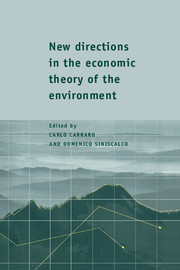Book contents
- Frontmatter
- Contents
- List of contributors
- 1 Theoretical frontiers of environmental economics
- 2 Growth with natural and environmental resources
- 3 Environmental policy and technological innovation
- 4 Environmental policy, distortionary labour taxation and employment: pollution taxes and the double dividend
- 5 International coordination of environmental taxes
- 6 Environmental policy and international trade
- 7 Environmental regulation and international capital allocation
- 8 Towards a theory of international environmental cooperation
- 9 Group formation in games without spillovers
- 10 Non-cooperative models of coalition formation in games with spillovers
- Index
10 - Non-cooperative models of coalition formation in games with spillovers
Published online by Cambridge University Press: 11 January 2010
- Frontmatter
- Contents
- List of contributors
- 1 Theoretical frontiers of environmental economics
- 2 Growth with natural and environmental resources
- 3 Environmental policy and technological innovation
- 4 Environmental policy, distortionary labour taxation and employment: pollution taxes and the double dividend
- 5 International coordination of environmental taxes
- 6 Environmental policy and international trade
- 7 Environmental regulation and international capital allocation
- 8 Towards a theory of international environmental cooperation
- 9 Group formation in games without spillovers
- 10 Non-cooperative models of coalition formation in games with spillovers
- Index
Summary
Introduction
Since the publication of Theory of Games and Economic Behavior by von Neumann and Morgenstern (1944), the study of coalition formation has been one of the central questions in game theory. In the words of its founders, one of the purposes of game theory is to ‘determine everything that can be said about coalitions between players, compensations between partners in every coalition, mergers or fights between coalitions…’ (von Neumann and Morgenstern (1944, p. 240)). This quotation clearly poses the three basic questions of endogenous coalition formation: Which coalitions will be formed? How will the coalitional worth be divided among coalition members? How does the presence of other coalitions affect the incentives to cooperate?
As noted by Maschler (1992) in his survey on bargaining sets, cooperative game theory has focused mostly on the second question – the division of the payoff between coalition members. In fact, it is even surprising to note that the first question has been assumed away in most cooperative game theory. Even the Aumann–Maschler (1964) bargaining set, which was specially designed to analyse the formation of coalitions, specifies an exogenous coalition structure and falls short of determining which coalition struture will form. Finally, the third question, dealing with competition between coalitions, is simply ignored in traditional cooperative game theory, since the coalitional function cannot take into account externalities among coalitions.
In recent years, the limitations of cooperative game theoretic solution concepts has led to the emergence of a new strand of the literature describing the formation of coalitions as a non-cooperative process.
- Type
- Chapter
- Information
- New Directions in the Economic Theory of the Environment , pp. 311 - 352Publisher: Cambridge University PressPrint publication year: 1997
- 78
- Cited by



